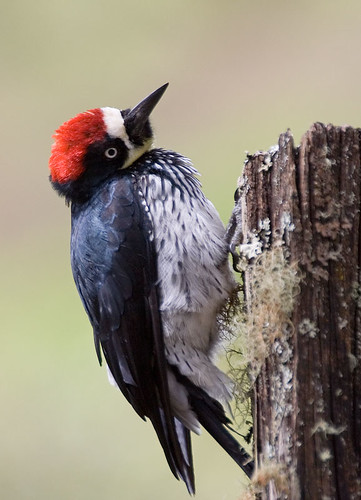The Acorn Woodpecker (Melanerpes formicivorus) is a medium-sized woodpecker, 21 cm long with an average weight of 85 g.
The adult has a black head, back, wings and tail, white forehead, throat, belly and rump. The eyes are white. The adult male has a red cap starting at the forehead, whereas females have a black area between the forehead and the cap. The white neck, throat and forehead patches are distinctive identifiers.
The adult has a black head, back, wings and tail, white forehead, throat, belly and rump. The eyes are white. The adult male has a red cap starting at the forehead, whereas females have a black area between the forehead and the cap. The white neck, throat and forehead patches are distinctive identifiers.
The breeding habitat is forested areas with oaks in the hills of coastal California and the southwestern United States south to Colombia. This species may occur at low elevations in the north of its range, but rarely below 1000m in Central America, and it breeds up to the timberline. The breeding pair excavate a nest in a large cavity in a dead tree or a dead part of a tree. A group of adults may participate in nesting activities: Field studies have shown that breeding groups range from monogamous pairs to breeding collectives of seven males and three females, plus up to 10 nonbreeding helpers. Young have been found with multiple paternity.
Acorn Woodpeckers, as their name implies, depend heavily on acorns for food. In some parts of their range (e.g., California), humans create granaries or "acorn trees" by drilling holes in dead trees, dead branches, and wooden buildings. The woodpeckers then collect acorns and find a hole that is just the right size for the acorn. As acorns dry out, they are moved to smaller holes and granary maintenance requires a significant amount of the bird's time.
The acorns are visible, and the group defends the tree against potential cache robbers like Steller's Jays and Western Scrub Jays. Acorns are such an important resource to the California populations that Acorn Woodpeckers may nest in the fall to take advantage of the fall acorn crop, a rare behavior in birds Acorn Woodpeckers are not storing the acorns in order to eat the insect larvae that ultimately form in the acorn, but for the acorn themselves. Acorn Woodpeckers can also be seen sallying from tree limbs to catch insects, eating fruit and seeds, and drilling holes to drink sap.
This bird is a permanent resident throughout its range. They may relocate to another area if acorns are not readily available. It is sedentary and very sociable.
The acorns are visible, and the group defends the tree against potential cache robbers like Steller's Jays and Western Scrub Jays. Acorns are such an important resource to the California populations that Acorn Woodpeckers may nest in the fall to take advantage of the fall acorn crop, a rare behavior in birds Acorn Woodpeckers are not storing the acorns in order to eat the insect larvae that ultimately form in the acorn, but for the acorn themselves. Acorn Woodpeckers can also be seen sallying from tree limbs to catch insects, eating fruit and seeds, and drilling holes to drink sap.
This bird is a permanent resident throughout its range. They may relocate to another area if acorns are not readily available. It is sedentary and very sociable.






No comments:
Post a Comment